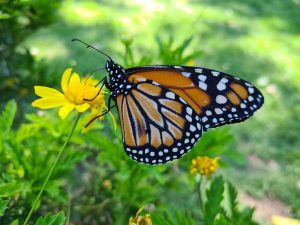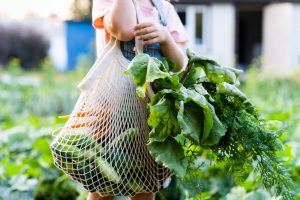That’s what they say – but we all know they bring more than flowers. April showers set the stage for another gardening season here in the Orillia area, and the variety of flowers, shrubs, fruits and vegetables we can cultivate in our backyards gets more varied and abundant every year.
This year Sustainable Orillia is encouraging all our gardening friends and neighbours to keep three priorities in mind as you finalize your plans for the growing season ahead.

Prioritize Pollinators. Without birds, bees, butterflies and other pollinators spreading the all-essential pollen from one bloom to the next, somewhere between 80% to 95% of all plant species would be in jeopardy. Planting with pollinators in mind will reinforce the vitality of your garden.
Guidelines to consider when creating a pollinator garden include:
• design and plant species that bloom in sequence, throughout the season
• plant in bunches of 5 to 9 plants or more; pollinators are attracted by bigger groupings or waves
• stay pesticide free – consider lady-bugs as a natural alternative
• consider milkweed for the Monarch butterflies
• avoid double-bloom varieties – as they can pose a barrier for pollinators
• where possible, leave a section of your garden or yard undisturbed, un-mulched and un-watered for those insects who live in the ground, which, surprisingly, includes about 70% of our native bees.
Orillia has a number of pollinator gardens around the city that you can visit and use as a reference in your planning. Supporting pollinators helps protect the balance of nature and the future of our environment. The more we help the ‘birds and the bees,’ the better it will be for us all.
Prioritize Local. Native or local plants bring sustainable diversity to our gardens and they are very much in harmony with the priority referenced above as they are a source of nectar, pollen and seeds for all our pollinating friends. Native plants are those that grow naturally in our region and, as a result, they are more adapted to our climate and soil conditions. For the most part, they should require less maintenance than imported varieties. There are more than enough local plants to provide colour and interest throughout your garden. Local plants include Black-Eyed Susans, Red and White Trilliums, Bee Balm, Wild Geraniums, Purple Coneflowers and many, many more. Consult with your local Garden Centre for expert advice on the local plants they carry and how to incorporate them into your garden plans. And don’t forget flowering shrubs like Lilacs and Dogwood—and fruit trees—all of which add so much colour to your spring gardens.
Prioritize Fruits and Vegetables. There’s nothing more rewarding (and tasty) than growing your own fresh fruits and vegetables. Whether part of a community garden, on a window ledge, or just outside your kitchen door, the satisfaction of producing healthy food, saving money and reducing carbon emissions makes the effort worthwhile. So much of our food is transported from other regions or, frequently, from other countries. Whatever we can grow locally will help reduce emissions from large-scale farming, storage, refrigeration and transportation. Plus, locally grown food can provide some assurance of supply, as supply chains are already under pressure and could be challenged more in the years ahead.
 There are lots of fruits and vegetables that grow happily in our hardiness zone (zones 4-5), many of which can be preserved for later consumption. Blueberries, strawberries and raspberries are a good example of summer bounty that can be frozen and brought deliciously to the table mid-winter. And ask any Italian chef what makes the best pasta sauce – it’s home-grown tomatoes, preserved and ready to add flavour and nutrition to any meal. The list is long. Zucchini comes to mind, as do apples. Prioritizing fruits and vegetables in your garden has another benefit, as some varieties, while growing in your garden, may also act as a deterrent for insects. Garlic and basil are two examples.
There are lots of fruits and vegetables that grow happily in our hardiness zone (zones 4-5), many of which can be preserved for later consumption. Blueberries, strawberries and raspberries are a good example of summer bounty that can be frozen and brought deliciously to the table mid-winter. And ask any Italian chef what makes the best pasta sauce – it’s home-grown tomatoes, preserved and ready to add flavour and nutrition to any meal. The list is long. Zucchini comes to mind, as do apples. Prioritizing fruits and vegetables in your garden has another benefit, as some varieties, while growing in your garden, may also act as a deterrent for insects. Garlic and basil are two examples.
If you don’t have the yard space or inclination to grow your own fruits and vegetables, don’t despair. We are lucky to have excellent local farmers’ markets in the area where we can shop for fresh, locally-grown produce. Watch for Sustainable Orillia’s upcoming ‘Farmers’ Market Map,’ currently in development and soon to be accessible on our website with up-to-date information on where you can shop for fresh, locally-grown fruits. vegetables and more.
As we move closer to all those May flowers pushing up through the soil and brightening our world once again, we hope this TIP reminds you to support your local growers or, better yet, become one. By prioritizing pollinators, local plants and edible crops in your home or community garden, you are helping restore nature’s balance and creating a healthier local ecosystem.
_____________
